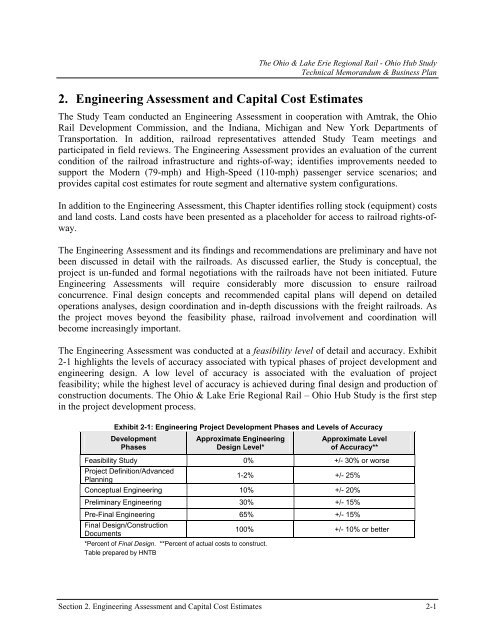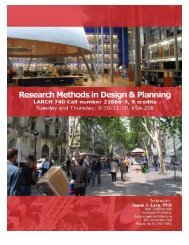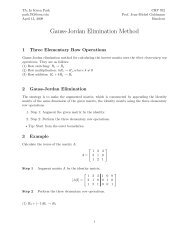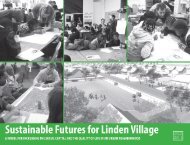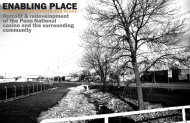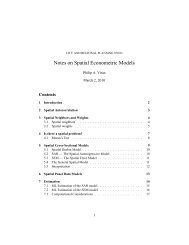- Page 2 and 3: The Ohio & Lake Erie Regional Rail
- Page 4 and 5: The Ohio & Lake Erie Regional Rail
- Page 6 and 7: Table of Contents The Ohio & Lake E
- Page 8 and 9: The Ohio & Lake Erie Regional Rail
- Page 10 and 11: Ohio & Lake Erie Regional Rail - Th
- Page 12 and 13: Study Approach and Methodology The
- Page 14 and 15: Travel Times and Passenger Fares Wi
- Page 16 and 17: The table below lists the 2025 oper
- Page 18 and 19: The capital plan for the three new
- Page 20 and 21: The Economic Impact of the Ohio Hub
- Page 22 and 23: Ohio Hub System with Incremental Co
- Page 24 and 25: The Ohio & Lake Erie Regional Rail
- Page 26 and 27: The Ohio & Lake Erie Regional Rail
- Page 28 and 29: The Ohio & Lake Erie Regional Rail
- Page 30 and 31: The Ohio & Lake Erie Regional Rail
- Page 34 and 35: The Ohio & Lake Erie Regional Rail
- Page 36 and 37: The Ohio & Lake Erie Regional Rail
- Page 38 and 39: The Ohio and Lake Erie Regional Rai
- Page 40 and 41: The Ohio & Lake Erie Regional Rail
- Page 42 and 43: The Ohio & Lake Erie Regional Rail
- Page 44 and 45: The Ohio & Lake Erie Regional Rail
- Page 46 and 47: The Ohio & Lake Erie Regional Rail
- Page 48 and 49: The Ohio & Lake Erie Regional Rail
- Page 50 and 51: The Ohio & Lake Erie Regional Rail
- Page 52 and 53: The Ohio & Lake Erie Regional Rail
- Page 54 and 55: The Ohio & Lake Erie Regional Rail
- Page 56 and 57: The Ohio & Lake Erie Regional Rail
- Page 58 and 59: The Ohio & Lake Erie Regional Rail
- Page 60 and 61: The Ohio & Lake Erie Regional Rail
- Page 62 and 63: Exhibit 2-17: Segment 4 - Beaver Fa
- Page 64 and 65: The Ohio & Lake Erie Regional Rail
- Page 66 and 67: Segment 2: Berea-Toledo The Ohio &
- Page 68 and 69: The Ohio & Lake Erie Regional Rail
- Page 70 and 71: The Ohio & Lake Erie Regional Rail
- Page 72 and 73: The Ohio & Lake Erie Regional Rail
- Page 74 and 75: The Ohio & Lake Erie Regional Rail
- Page 76 and 77: The Ohio & Lake Erie Regional Rail
- Page 78 and 79: The Ohio & Lake Erie Regional Rail
- Page 80 and 81: The Ohio & Lake Erie Regional Rail
- Page 82 and 83:
Cost Category Exhibit 2-35: Segment
- Page 84 and 85:
The Ohio & Lake Erie Regional Rail
- Page 86 and 87:
Cost Category Exhibit 2-36: Segment
- Page 88 and 89:
The Ohio & Lake Erie Regional Rail
- Page 90 and 91:
The Ohio & Lake Erie Regional Rail
- Page 92 and 93:
Cost Category Segment 1 Cleveland-
- Page 94 and 95:
The Ohio & Lake Erie Regional Rail
- Page 96 and 97:
The Ohio & Lake Erie Regional Rail
- Page 98 and 99:
The Ohio & Lake Erie Regional Rail
- Page 100 and 101:
The Ohio & Lake Erie Regional Rail
- Page 102 and 103:
The Ohio & Lake Erie Regional Rail
- Page 104 and 105:
The Ohio & Lake Erie Regional Rail
- Page 106 and 107:
The Ohio & Lake Erie Regional Rail
- Page 108 and 109:
The Ohio & Lake Erie Regional Rail
- Page 110 and 111:
The Ohio & Lake Erie Regional Rail
- Page 112 and 113:
The Ohio & Lake Erie Regional Rail
- Page 114 and 115:
The Ohio & Lake Erie Regional Rail
- Page 116 and 117:
The Ohio & Lake Erie Regional Rail
- Page 118 and 119:
The Ohio & Lake Erie Regional Rail
- Page 120 and 121:
The Ohio & Lake Erie Regional Rail
- Page 122 and 123:
The Ohio & Lake Erie Regional Rail
- Page 124 and 125:
The Ohio & Lake Erie Regional Rail
- Page 126 and 127:
The Ohio & Lake Erie Regional Rail
- Page 128 and 129:
The Ohio & Lake Erie Regional Rail
- Page 130 and 131:
The Ohio & Lake Erie Regional Rail
- Page 132 and 133:
The Ohio & Lake Erie Regional Rail
- Page 134 and 135:
The Ohio & Lake Erie Regional Rail
- Page 136 and 137:
Cost Category The Ohio & Lake Erie
- Page 138 and 139:
The Ohio & Lake Erie Regional Rail
- Page 140 and 141:
The Ohio & Lake Erie Regional Rail
- Page 142 and 143:
The Ohio & Lake Erie Regional Rail
- Page 144 and 145:
The Ohio & Lake Erie Regional Rail
- Page 146 and 147:
The Ohio & Lake Erie Regional Rail
- Page 148 and 149:
The Ohio & Lake Erie Regional Rail
- Page 150 and 151:
The Ohio & Lake Erie Regional Rail
- Page 152 and 153:
The Ohio & Lake Erie Regional Rail
- Page 154 and 155:
The Ohio & Lake Erie Regional Rail
- Page 156 and 157:
The Ohio & Lake Erie Regional Rail
- Page 158 and 159:
The Ohio & Lake Erie Regional Rail
- Page 160 and 161:
The Ohio & Lake Erie Regional Rail
- Page 162 and 163:
The Ohio & Lake Erie Regional Rail
- Page 164 and 165:
The Ohio & Lake Erie Regional Rail
- Page 166 and 167:
The Ohio & Lake Erie Regional Rail
- Page 168 and 169:
The Ohio & Lake Erie Regional Rail
- Page 170 and 171:
The Ohio & Lake Erie Regional Rail
- Page 172 and 173:
The Ohio & Lake Erie Regional Rail
- Page 174 and 175:
The Ohio & Lake Erie Regional Rail
- Page 176 and 177:
The Ohio & Lake Erie Regional Rail
- Page 178 and 179:
The Ohio & Lake Erie Regional Rail
- Page 180 and 181:
The Ohio & Lake Erie Regional Rail
- Page 182 and 183:
The Ohio & Lake Erie Regional Rail
- Page 184 and 185:
Exhibit 2-66: Costs for Right-Of-Wa
- Page 186 and 187:
The Ohio & Lake Erie Regional Rail
- Page 188 and 189:
The Ohio & Lake Erie Regional Rail
- Page 190 and 191:
The Ohio & Lake Erie Regional Rail
- Page 192 and 193:
The Ohio & Lake Erie Regional Rail
- Page 194 and 195:
The Ohio & Lake Erie Regional Rail
- Page 196 and 197:
The Ohio & Lake Erie Regional Rail
- Page 198 and 199:
The Ohio & Lake Erie Regional Rail
- Page 200 and 201:
Exhibit 3-3: Available Technologies
- Page 202 and 203:
The Ohio & Lake Erie Regional Rail
- Page 204 and 205:
The Ohio & Lake Erie Regional Rail
- Page 206 and 207:
The Ohio & Lake Erie Regional Rail
- Page 208 and 209:
The Ohio & Lake Erie Regional Rail
- Page 210 and 211:
The Ohio & Lake Erie Regional Rail
- Page 212 and 213:
4. Travel Demand and Forecasting Th
- Page 214 and 215:
The Ohio & Lake Erie Regional Rail
- Page 216 and 217:
The Ohio & Lake Erie Regional Rail
- Page 218 and 219:
Exhibit 4-6 Income Distribution of
- Page 220 and 221:
The Ohio & Lake Erie Regional Rail
- Page 222 and 223:
Exhibit 4-10: Population Growth For
- Page 224 and 225:
The Ohio & Lake Erie Regional Rail
- Page 226 and 227:
Exhibit 4-13: Key Components of Typ
- Page 228 and 229:
The Ohio & Lake Erie Regional Rail
- Page 230 and 231:
The Ohio & Lake Erie Regional Rail
- Page 232 and 233:
The Ohio & Lake Erie Regional Rail
- Page 234 and 235:
The Ohio & Lake Erie Regional Rail
- Page 236 and 237:
The Ohio & Lake Erie Regional Rail
- Page 238 and 239:
The Ohio & Lake Erie Regional Rail
- Page 240 and 241:
The Ohio & Lake Erie Regional Rail
- Page 242 and 243:
The Ohio & Lake Erie Regional Rail
- Page 244 and 245:
Segment-specific Assumptions The Oh
- Page 246 and 247:
The Ohio & Lake Erie Regional Rail
- Page 248 and 249:
The Ohio & Lake Erie Regional Rail
- Page 250 and 251:
The Ohio & Lake Erie Regional Rail
- Page 252 and 253:
Exhibit 6-7: Station Staffing Summa
- Page 254 and 255:
The Ohio & Lake Erie Regional Rail
- Page 256 and 257:
The Ohio & Lake Erie Regional Rail
- Page 258 and 259:
The Ohio & Lake Erie Regional Rail
- Page 260 and 261:
The Ohio & Lake Erie Regional Rail
- Page 262 and 263:
The Ohio & Lake Erie Regional Rail
- Page 264 and 265:
The Ohio & Lake Erie Regional Rail
- Page 266 and 267:
The Ohio & Lake Erie Regional Rail
- Page 268 and 269:
The Ohio & Lake Erie Regional Rail
- Page 270 and 271:
The Ohio & Lake Erie Regional Rail
- Page 272 and 273:
The Ohio & Lake Erie Regional Rail
- Page 274 and 275:
Consumer Surplus = (C 1 - C 2 )*T 1
- Page 276 and 277:
The Ohio & Lake Erie Regional Rail
- Page 278 and 279:
The Ohio & Lake Erie Regional Rail
- Page 280 and 281:
The Ohio & Lake Erie Regional Rail
- Page 282 and 283:
The Ohio & Lake Erie Regional Rail
- Page 284 and 285:
The Ohio & Lake Erie Regional Rail
- Page 286 and 287:
The Ohio & Lake Erie Regional Rail
- Page 288 and 289:
The Ohio & Lake Erie Regional Rail
- Page 290 and 291:
The Ohio & Lake Erie Regional Rail
- Page 292 and 293:
The Ohio & Lake Erie Regional Rail
- Page 294 and 295:
The Ohio & Lake Erie Regional Rail
- Page 296 and 297:
The Ohio & Lake Erie Regional Rail
- Page 298 and 299:
The Ohio & Lake Erie Regional Rail
- Page 300 and 301:
The Ohio & Lake Erie Regional Rail
- Page 302 and 303:
The Ohio & Lake Erie Regional Rail
- Page 304 and 305:
The Ohio & Lake Erie Regional Rail
- Page 306 and 307:
The Ohio & Lake Erie Regional Rail
- Page 308 and 309:
Exhibit 10-3: Ohio Hub Network Usin
- Page 310 and 311:
The Ohio & Lake Erie Regional Rail


